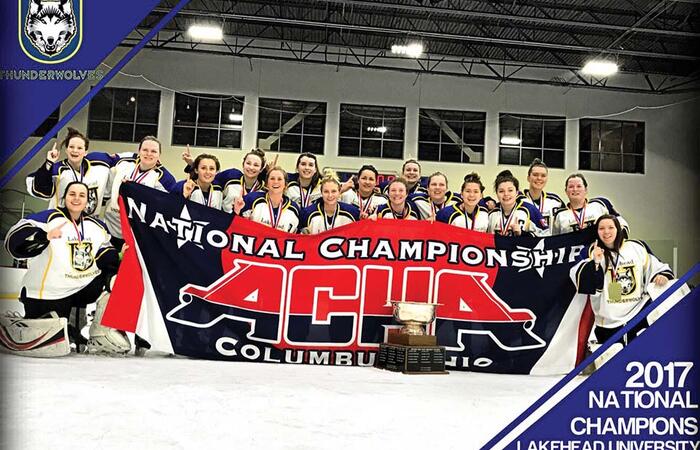It was a special and historic day at the Northwestern Ontario Sports Hall of Fame (NWOSHOF) on August 21st when Michela Cava was on hand to help raise a Professional Women’s Hockey League (PWHL) flag in celebration of her 2024 and 2025 back-to-back Walter Cup victories with Minnesota. The tradition of the NWOSHOF flying a flag to symbolize excellence in sport goes back to the summer of 2013 when we raised the Chicago Blackhawks flag to honour five individuals with ties to our region who were a part of that Stanley Cup winning team. Since then we have flown the NHL flags of the Pittsburgh Penguins, St. Louis Blues and Florida Panthers.
During her comments that day Michela noted how proud she was to be the first female hockey player to have a flag raised in her honour. Cava, along with all of the women from our region who are taking to the ice this hockey season, are carrying on a tradition of women’s hockey at the Lakehead that goes back over a century. Reports of skirt-wearing players appeared in local papers as early as the late 1890s, with a 1907 article in the Fort William Daily Times Journal reporting on a meeting being held to organize a ladies’ hockey club.
In the early 1920s the ladies had made the transition from skirts to bloomers and by the late 1920s women’s hockey was becoming more organized across the country. Locally teams such as the Port Arthur North Ends, South Ends and the Fort William Y were competing in the Thunder Bay Ladies Hockey League.
In March of 1928 nearly two thousand fans were on hand at the Arena rink to see the Port Arthur South Ends defeat the Manitoba University Co-eds. That victory earned them the 1927-28 Western Canadian Ladies Hockey Championship title and the chance to vie for what was referred to in the papers at that time as the Canadian championships. The two-game, total goal series was held in Port Arthur and the challengers were the Toronto Aura Lee who were considered one of the finest teams in the country.
The Southies, as the newspaper called them, put in a strong showing in front of their hometown crowd who had filled the Arena rink, holding their opponents to a 1-0 lead, up until the last two-minutes of the first game when two quick goals saw the Aura Lee go up 3-0 in the series. Adding five more in the second game Toronto claimed the national title by a score of 8-0.
By the 1930s bloomers eventually gave way to hockey pants and jerseys and women’s hockey was becoming much more organized leading to the formation in 1933 of the Dominion Women’s Amateur Hockey Association. In the mid-1930s the Lakehead Maroons and the Twinports competed in an intercity playdown to see who would advance to the Eastern championships and local rinks hosted such teams as the Port Arthur Roughriders, Campbell Daredevils and Pine Street Co-eds.
Breaking down barriers for women on the administrative side of hockey during the 1940s was Hilda (Fiori) Donati who started her very own pee wee hockey league. In its first year of operation, Hilda’s League, as it was called, consisted of eight teams, with each one of the young male players being personally selected, assigned and outfitted by this one-woman dynamo. By 1948, the league had grown to include over 20 teams and over 300 players, with its founder being referred to as Mrs. Hockey in an article published that year by MacLean’s Magazine. The league continued on until the early 1950s with many of Hilda’s League graduates going on to enjoy successful hockey careers.
The 1940s and 50s saw such teams as the Red Wings, Blue Bombers, Bearcats, Flying Forts and Buckaroos competing in the Lakehead Girl’s Hockey League, with top teams advancing to competitions across Canada. The Port Arthur Bearcats travelled to Moose Jaw to compete for the national title, losing out to the hometown Wildcats in the 1951 All Girls Dominion Championships. During the 1960s and 70s women’s hockey began to compete with other sports such as broomball and ringette which were growing in popularity during that time.
By the 1980s women’s hockey was once again in the headlines with the formation of the Thunder Bay Women’s Hockey Association which continues to host teams at all levels of competition.
The Thunder Bay Queens, who are celebrating their 30th anniversary this coming season, have brought home multiple provincial titles as well as national gold from the 2010 Esso Cup and a 2012 national silver medal. In 2017 and 2018 it was the women of Lakehead University who did well on the ice winning back-to-back American Collegiate Hockey Association (ACHA) D2 National Championship titles.
As more and more opportunities to play competitive hockey became available, our young women went on to shine on the world stage including Olympic and World gold medalists Katie Weatherston and Haley Irwin, with Irwin also currently involved in the PWHL as a coach with the Ottawa Charge. Many others have earned university and college scholarships, played on high level amateur teams and joined the professional ranks.
Given the strong women’s hockey programs that continue to operate in our region, there is no doubt in my mind that we will be raising many more flags in honour of our incredible women hockey players in the future.













